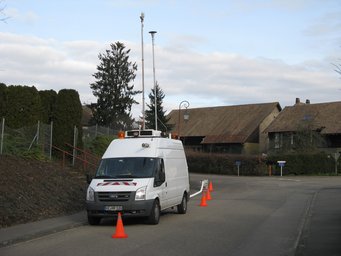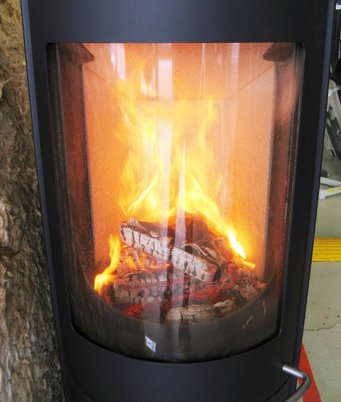Heating with wood: climate-friendly – but also clean?
In a comprehensive study of wood-burning facilities of different sizes, researchers at the Max Planck Institute for Chemistry have investigated how it is possible to heat with biomass while minimizing effects on air quality.
A crackling wood fire conveys coziness. Heating with renewable raw materials is also considered a more climate-friendly alternative to oil or gas heating. That’s why increasingly more and more households are switching to such sustainable fuels in form of logs, wood chips, and pellets. However, it is also known that burning wood is associated with considerable particulate emissions – even with modern small-scale combustion systems that comply with the latest legal requirements. A series of field studies conducted by the Max Planck Institute for chemistry revealed that simple installations, such as private wood stoves, led to a measurable increase in particulate matter concentrations in their vicinity. Thus, even a single fireplace significantly worsened the air quality in the immediate neighborhood. Measurements in two villages in winter showed a greater contribution to local particulate matter pollution from heating with wood than from road traffic. However, measurements in the vicinity of larger, municipal facilities proved that this does not have to be the case. A plant, that in addition to controlled combustion is equipped with an efficient flue gas cleaning system and a high chimney, did not show any detectable influence on local air quality.

Properly planned, centralized heat supply using renewable resources can make a valuable contribution to more climate-friendly heating without compromising air quality in the community. Frank Drewnick, an aerosol analyst who heads a research group at the Max Planck Institute for Chemistry, says: “There are three things to be taken into account. The combustion must be complete (i.e. as controlled as possible and with a suitable fuel), the chimney must be sufficiently high, and the facility must be equipped with good flue gas cleaning technology. Then biomass can be used for ‘green’ heating without unnecessarily polluting the air in the surrounding area”.
Drewnick and his colleague Friederike Fachinger found these conditions at a municipal wood-burning facility in a village in the Black Forest, where they realized a part of their field study funded by the European Union. Even with their sensitive analytical methods, the scientists were unable to detect any deterioration in air quality of the surrounding area that could be attributed to the facility when they measured the pollutant distribution. On the other hand, wood-burning stoves or open fireplaces usually do not fulfil the above conditions. “If you don’t want to affect the air in your own neighborhood, you should avoid ‘cozy” fires at home”, concludes Drewnick.
He bases his statements on emission and immission measurements that he conducted together with chemist Fachinger at and in the vicinity of small and medium-sized wood-burning facilities. The findings from the analyses resulted in three scientific publications.

Extensive measurements with the mobile research laboratory MoLa
All measurements in this research project which were part of the BIOCOMBUST research project, were carried out with the same, extensive measurement set-up in the mobile aerosol research laboratory MoLa of the Max Planck Institute for Chemistry. The data obtained in the flue gas stream and in the environment can therefore be readily compared. They also provide further information in the overall view – for example, on the size and chemical composition of the particles emitted and how they develop in the atmosphere. “Incomplete combustion produces considerable amounts of soot as well as uncombusted organic vapors. After the flue gases have cooled down or as a result of chemical processes, these vapors can condense in the ambient air and either form further particles or cause existing particles to grow”, says Fachinger. This can additionally contribute to fine particulate air pollution.
Remote villages in the Upper Black Forest and Alsace as study sites
In two remote villages in the Upper Black Forest and Alsace with 2,500 and 400 inhabitants, respectively, Drewnick and Fachinger studied how air pollutants are distributed in the environment. In both villages, there is a central communal burning incinerator that heats part of the houses via district heating. Other households use their own wood stoves to heat with fuel from the immediate surroundings.
These immission measurements, which document the effects of pollutant emissions from various sources on the surrounding air, allowed for a particularly practical view. “With the mobile measurements in the villages, we were able to examine the connection between emission events and air quality under real conditions. People didn’t even know that we were measuring. They heated their buildings just as they always had”, says Fachinger. In summer, for example, the researchers were able to observe how strongly even a single fire can affect the air quality in the immediate area.
Emissions depend on combustion conditions and flue gas cleaning
Especially in winter, emissions from wood burning contributed more to local fine particulate air pollution than road traffic. The sources of emissions were quite unevenly distributed. While the emissions from the smaller of the two incinerators as well as from the private wood stoves were clearly visible in the distribution of pollutants in the villages, the Max Planck researchers were unable to detect the cloud of flue gas from the larger facility in the village. This is because the facility is equipped with a high chimney and a particularly efficient flue gas cleaning system that also separates small particles.
Overall, the measurements have confirmed that emissions are significantly increased in the case of incomplete combustion (e.g. in the case of incompletely dried wood or during kindling or burnout) or with improper air supply. Simple flue gas cleaning processes often remove only the larger suspended particles. For an effective reduction of even small particles, more elaborate flue gas cleaning methods are necessary in addition to controlled combustion. These can be used in an economically viable way, especially in larger facilities. “With such methods it is definitely possible to heat in a way that is both climate-friendly and clean”, says Drewnick, summarizing the study results.
The study was supported by:
Interreg IV Program Upper Rhine of the European Union
Project C35 BIOCOMBUST

